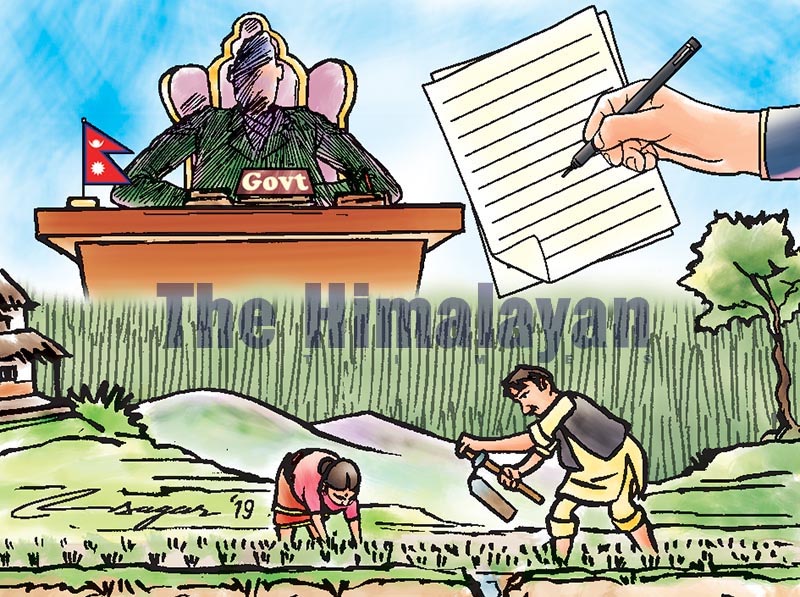Agricultural subsidies: Are they effective?
Long-term subsidy might stifle innovation and make the producers less competitive and more dependent on the government. Subsidy programmes need reform, with the long-term goal being to repeal all farm subsidies and shift to crop insurance
Food production is more important to a nation’s welfare than other business products. Delivering easy access to food for everyone is a monumental challenge. Agriculture suffers from the perception of being high risk but with modest returns. In most of the cases, farmers rely on loans; they borrow in the spring to plant seeds and pay the debt in the fall after selling the successful harvest. This makes farming a gamble.
As an agrarian nation, Nepal’s agriculture policies give priority to subsidies to boost production, improve food security and reduce poverty. Currently, the government has been allocating around Rs 18 billion to provide subsidies each year. But there is considerable debate regarding the effectiveness and efficiency of their uses.
In Nepal, agriculture subsidy was common during the late 1950s and early 1970s but declined in the late 1990s. But again the federal and state governments have given it a boost. Agriculture subsidies are aimed at making available inputs to the users at below market costs to increase agriculture productivity and profitability to stimulate economic growth. The government has raised interest subsidy on agriculture loans to 5 per cent, waiving 50 per cent on interest rates for those who seek bank credits to engage in commercial agriculture. It has spent Rs 758.2 million on subsidising the interest and has a plan to provide 10,000 youths Rs 14.39 billion in concessional loans in five years to prevent their exodus. The government must, however, closely monitor the progress before this invites a fiscal crisis.
It seems that the results and objectives of the agricultural subsidy programme do not converge very well as a big chunk of it is spent in covering the administrative costs. But we need to have an in-depth analysis on who has garnered most of the subsidies as well as the resultant gain in income. What if our subsidies are exacerbating inequality of income and asset distribution? We need to know who has access to subsidies - poor or non-poor. Are marginalised people able to utilise subsidies in a system of co-payment?
In recent decades, agriculture productivity in low income countries has fallen increasingly behind. Adequate use of agricultural inputs, such as improved seeds, inorganic fertiliser and irrigation, has been identified as one of the best ways of enhancing agricultural productivity. However, they can be financially unaffordable to many poor farmers.
Farm subsidies and trade protections in China and India harm Nepal, and undermine our efforts at economic reform. Indian subsidies make their products cheaper, causing them to flood the Nepali market. This has led to increased imports of agricultural products in the total commodity trade. So the overall agriculture system and subsidy scheme should be reviewed to increase commercial engagement, production and productivity in agriculture.
Today, most of the subsidies are channeled through local governments. It is essential to have a quick look at where the subsidies go and how they are being used. It has been reported that the bulk of the subsidies is benefitting the largest and wealthiest farm households, and there are many startups with the announcement of subsidies. There are also ample cases of subsidy programmes being subjected to bureaucratic waste and recipient fraud. So unless agriculture subsidies are handled charily, they could subvert efforts to promote efficiency and sustainable agriculture, with no proven guarantee of increasing productivity, efficiency and global competitiveness.
The Subsidy Management Procedure-2019 aims to make the distribution of subsidy transparent by maintaining good governance. The government must think of reducing subsidy to individual farmers and agro-enterprises, and support agriculture co-operatives instead. It should be invested to replace the traditional and indigenous farming technology. The focus of the subsidy should be on fertilisers, quality seeds and irrigation, and promotion of insurance and agriculture risk coverage schemes.
Subsidy must not create moral hazards for the farmers - it should not induce them to make decisions that maximise their subsidies, but improve market efficiency. Instant slash of farm subsidies will not make sense, but, in general, subsidies should be employed to change the behaviour and solve specific problems rather than to serve as a long-term crutch for the producers. Long-term subsidy might stifle innovation and make the producers less competitive and more dependent on the government. At present, priority should be given on reforming subsidy programmes, but the long-term goal should be to repeal all farm subsidies, and shifting it to crop insurance (agriculture risk coverage, price loss compensation) before farmers become addicted to subsidy.
The current policies and programmes on agriculture subsidies must be aligned with the overall support framework, including better infrastructure, research, knowledge dissemination, capacity building and market support provision. Now, we need to assess whether agriculture subsidies are the best way to address food security or not. In the future, it will be sobering to contemplate why marginal farmers are starving because of their financial scarcity to afford subsidised agricultural products.
Timilsina is an agri-analytics officer at Gham Power Nepal






